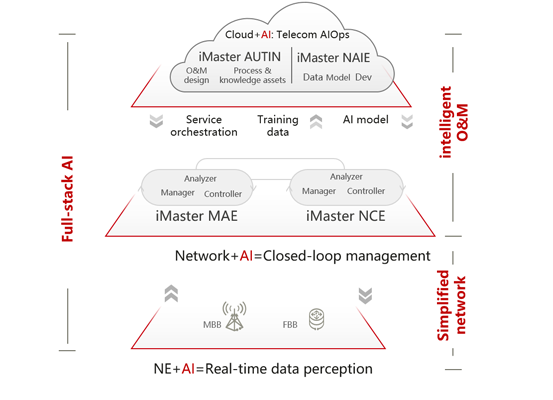Huawei Networks
Huawei takes the lead in introducing big data, AI, and next-generation protocols to IP networks to redefine data analysis and closed-loop optimization, marking a leap from traditional to intelligent IP networks. Huawei firmly believes intelligent IP networks have the following differentiators:

Super Capacity
Is the ultimate goal of intelligent IP network development. Currently, applications such as video, telecommuting, cloud computing, and AI are driving a new round of growth in network bandwidth. Campus networks are upgrading to Wi-Fi 6 and 100GE switches, while data centers and IP backbone networks are heading towards 400GE. With advancement in physical layer performance, and emerging network slicing technologies, such as FlexE, enterprises are able to utilize bandwidth more flexibly and efficiently. This makes it feasible to enjoy multiple services (including office, production, and computing) on one physical network. Hard bandwidth isolation between different service traffic provides 100% committed bandwidth for key services in vertical industries, enterprise production networks, and carrier IP private lines. The capability for intelligently adjusting slice bandwidth enables flexible adjustment of ultra-broadband networks based on service changes, better meeting service requirements.
Intelligent Experience
Is the foundation of the intelligent IP network architecture. Current IP networks have many uncertainties, both in terms of demand and supply. With regard to demand, services and networks ict solutions partner of choice ICT Choice Business Profile Page 12 cannot negotiate properly, and the service layer does not define clear expectations (service intents) for the network layer. When it comes to supply, the IP network is statistically multiplexed, and as services and traffic change, so too does network resource usage. To eliminate demand-side uncertainties, service intents need to be accurately sensed. Then, the service layer can notify the network layer about service requirements; or the network layer can deduce expectations for connection services by analyzing service traffic behavior (service model) to proactively identify terminals, users, and service types. Also, the network management, analysis, and control platform eliminates supply uncertainties by using AI algorithms, such as neural networks, to build network models, detect and analyze network status in real time, and understand network resource usage. Intelligent experience also entails matching service intents with network resources to continuously provide connection services that meet service expectations at minimal costs, achieving the “application-driven experience” goal.


Autonomous Driving
Is the key to improving user experience. Complaint-driven approaches currently pose significant challenges to network O&M. For instance, network O&M departments are usually the last to know about network problems, and therefore user experience cannot be guaranteed. Instead, predictive O&M is imperative. We need to detect network status in real time and determine whether problems or potential risks exist on networks. Through fault model matching, we can then accurately locate the root causes and automatically rectify faults. Doing so can help resolve network issues before they affect user experience, preventing services from being impacted.
